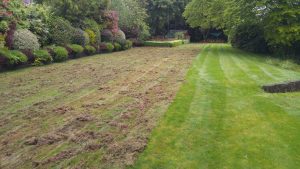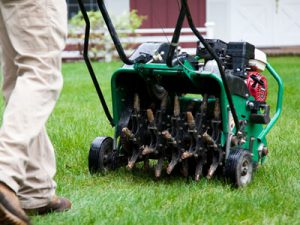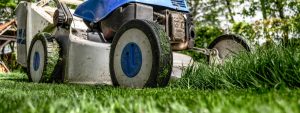As days lengthen, we venture outside and begin to notice how our lawns look. Many lawns struggle a little over the winter. Let’s look at what can be done now to get your lawn ready for a beautiful summer

Deal with lawn moss
1 – Moss
Moss in itself isn’t a problem. It’s green and soft under foot. Nice to look at a lovely to walk on. Come mid-summer your mossy lawn will yellow and die – not so good to look at or walk on then!
Moss is relatively easy to rake out of your lawn provided there is not much of it. If your lawn has a heavy moss burden then a petrol driven scarifier will be needed. I have two important rules. 1) Always apply a moss killing treatment after you have raked or scarified your lawn to kill and loose pieces of moss. 2) Never, ever mow into moss. If you have moss in your lawn that you can’t remove then raise your mower blades so the grass leaf is at least 2cm above the moss.

Power-rake moss out of your lawn
2 – De-thatch
Thatch is a layer of organic matter on top of the soil above the roots of your grass plants. It has little or no microbial activity and will not decompose. It prevents water and nutrition reaching the roots. Spring is the right time to dethatch turf. Cutting into the thatch to introduce air spaces is ideal. Boosting microbial activity with a professional bio-booster or compost tea

Aerate to aid root development
3 – Aerate
Aeration is by far the most beneficial mechanical process for your lawn. Organic matter is essential for the life within your soil. That life consists of beneficial fungi and bacteria which make micronutrients available to grass. In addition, there are worms and insects all responsible for breaking down organic matter. These living things need the 3 building blocks of life – water, air and food. Roots grow in the air gaps between the soil particles not in the soil itself. By aerating your lawn, you are introducing the air gaps essential to support that soil activity. In addition, aeration relieves compaction and helps reduce waterlogging too.

Remove leaves as soon as they fall
4 – Rake
Leaves from trees, dead grass blades and moss can prevent moisture and nutrients from easily reaching the roots of your lawn. Using a spring rake helps you keep fit, but in addition it removes debris and helps the grass leaf stand upright. When things begin to grow again in the early spring it’s a good idea to give your lawn a bit of a hair-brush, get things standing to attention and ready for a mow. Spring raking removes lingering autumn leaves and grass blades that didn’t survive winter. Do it now!

Spring is ideal for sowing lawn seeds
5 – Over-seed.
Repair bare patches in your lawn by over-seeding. Remove the dead patch of grass with a rake. In-fill with John Innes #3 compost and mix seed into the top layer. Give it a good water and, to keep the moisture and birds off, cover it with a sheet of newspaper until the seed germinates

Learn how to fertilise your lawn correctly
6 – Fertilise
All living things need the right kind of food in the right quantities. Many lawn owners forget this Lawns need the right amount of Nitrogen, Potassium and Phosphorus throughout the year. The occasional sprinkle of a 3-in-1 spring feed from the garden centre is not really cutting it. You ideally want controlled-release nutrition, more of a lawn buffet than a Christmas dinner. This way you don’t have a huge flush of growth meaning you have to get the mower out of the shed as soon as you’ve put it away. If you are going to feed your own lawn focus on quality over quantity. Focus on feeding the soil and let the soil feed the plant. If in doubt, speak to a lawn care professional

kill lawn weeds in spring
7 – Weed control
Spring is the best time to get weeds under control. Catch weeds early in the season if you can. Leave weeds until later and you are likely to have all their seedlings to deal with too. Some weeds are harder to control than others and this is where professional grade weed control products become essential. Weed control is complex stuff but get it right and your lawn’s going to look great this summer.

How to water a lawn is important
8 – Water
Well wetting agents really. Along with air and food, lawns need water. Many home owners resist watering their lawns for fear of the cost or wastage. The good news is that it costs less than £5 to water the average sized lawn and you only really need to do that every other week. Now here’s the secret; lawn care professionals make use of wetting agents to make the water that’s applied work harder. Wetting agents are very affordable, they keep water in the root-zone and mean that you can apply half as much water, water less often whilst getting the same results.

Correct lawn mowing height is essential
9 – Mow
The majority of lawn issues I see can be traced back to a poor mowing regime. Get mowing right and you are half way towards a wonderful lawn. Make sure your mower blades are sharp. Mow frequently enough to not cut off more than ¼ of the leaf length each mow. Don’t always mow in the same direction – start from different places on the lawn. Ideally mulch mow, leaving clippings behind to feed the essential soil microbes.

 Established 2016
Established 2016



